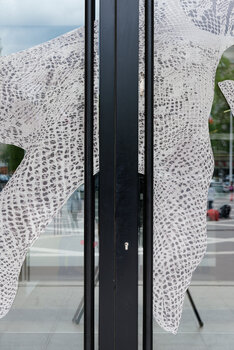Stitched Holes
Impression sur adhésif micro perforé.
Dimensions variables.
(2017)
As a photographie subject, lace recurs time and time again in William Henry FoxTalbot and Hippolyte Bayard’s 1830 and 1840s research for photo-sensitive procedures. Once in contact with a photo-sensitive surface and exposed to sunlight, the shadow cast by lace gives the illusion of being its image. Possibly because of its sometimes being seen as so many différent holes stitched together, it has an undoubtable relation to vision.
Stitched Holes takes as its starting point the image of a halfglove which Bayard made a photogram of in 1840. This half-glove is duplicated and re-constructed as a synthetic image in such a way as to form a virtually articulatable whole glove. Based on this matrix, a certain number of gestures are published in the form of images (piano tuning, pinpointing something, holding a cigarette between fingers...) The gestures refer to art history, semiology, and pornography, areas where vision takes precedence.
Needless to say, the glove is empty and thé stitched holes open onto the void. We may wonder: do the mechanics peculiar to lace still function if the latter does not cover anything ? But is it the case here?
The effect of lace is doubled by the surface of the print: a micro-perforated adhesive tape which makes it possible to see through the image, when you are on the dark side ofit. We therefore realize that it is possible to see from the inside of the glove.
Stitched Holes is a technological interplay around vision. It is part of the research that Aurélien Mole is undertaking around photography and the other technologies that he deals with by considering the various potentials of the technical imagination that is
particular to everyone.















